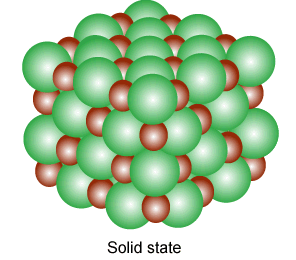Question:
Cells present in a cube-shaped ideal crystal of NaCl of mass 1.00 g ?
[Atomic masses : Na = 23, Cl = 35.5]
Cells present in a cube-shaped ideal crystal of NaCl of mass 1.00 g ?
[Atomic masses : Na = 23, Cl = 35.5]
Updated On: Jul 6, 2022
- $5.14 \times 10^{21}$ unit cells
- $1.28 \times 10^{21}$ unit cells
- $1.71 \times 10^{21}$ unit cells
- $2.57 \times 10^{21}$ unit cells
Hide Solution
Verified By Collegedunia
The Correct Option is D
Solution and Explanation
Mass of one unit-cell (m) = volume $\times$ density
$=a^{3} \times d $
$=a^{3} \times \frac{M z}{N_{0} a^{3}}=\frac{M z}{N_{0}} $
$ m =\frac{58.5 \times 4}{6.02 \times 10^{23}} g $
$\therefore$ Number of unit cells in $1 g =\frac{1}{m}$
$=\frac{6.02 \times 10^{23}}{58.5 \times 4}$
$=2.57 \times 10^{21}$
Was this answer helpful?
0
0
Top Questions on The solid state
- A metal crystallizes in simple cubic lattice. The volume of one unit cell is \( 6.4 \times 10^{-7} \, \text{pm}^3 \). What is the radius of the metal atom in pm?
- AP EAPCET - 2025
- Chemistry
- The solid state
- A metal crystallises in two cubic phases, fcc and bcc with edge lengths 3.5 Å and 3 Å respectively. The ratio of densities of fcc and bcc is approximately
- TS EAMCET - 2025
- Chemistry
- The solid state
- The percentage of free space in a body-centred cubic unit cell is
- Bihar Board XII - 2025
- Chemistry
- The solid state
- How many kinds of Bravais lattice are possible in a crystal?
- Bihar Board XII - 2025
- Chemistry
- The solid state
- Which of the following is not a crystalline solid?
- Bihar Board XII - 2025
- Chemistry
- The solid state
View More Questions
Concepts Used:
Solid State
Solids are substances that are featured by a definite shape, volume, and high density. In the solid-state, the composed particles are arranged in several manners. Solid-state, in simple terms, means "no moving parts." Thus solid-state electronic devices are the ones inclusive of solid components that don’t change their position. Solid is a state of matter where the composed particles are arranged close to each other. The composed particles can be either atoms, molecules, or ions.

Types of Solids:
Based on the nature of the order that is present in the arrangement of their constituent particles solids can be divided into two types;
- Amorphous solids behave the same as super cool liquids due to the arrangement of constituent particles in short-range order. They are isotropic and have a broad melting point (range is about greater than 5°C).
- Crystalline solids have a fixed shape and the constituent particles are arranged in a long-range order.